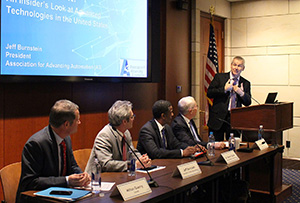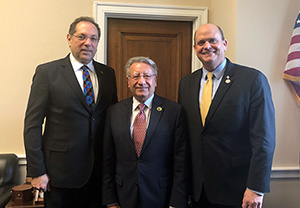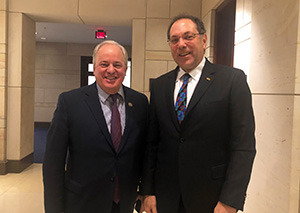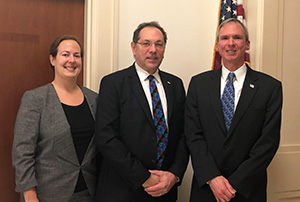ASME Hosts Briefing Highlighting Challenges and Opportunities Facing Robotics in the United States
ASME Hosts Briefing Highlighting Challenges and Opportunities Facing Robotics in the United States
On December 12, ASME sponsored a briefing on Capitol Hill to highlight “Robotics in the Manufacturing Environment: An Insider’s Look at Advanced Technologies in the United States.” The event was co-sponsored by the Robotics Institute at Carnegie Mellon, the Computing Research Association, IEEE-USA and the Robotic Industries Association (RIA) and convened in conjunction with the Congressional Robotics Caucus and the Congressional Manufacturing Caucus in the U.S. House of Representatives. The purpose of the briefing was to inform members of Congress and congressional staff on what industry leaders are doing to prepare for the future adoption of robotics technologies in the manufacturing environment.
ASME brought together a panel of leading experts in the field of robotics to share their thoughts and insights on opportunities and challenges facing the future of manufacturing robotics, as well as how government, industry and universities are collaborating to ensure the United States maintains leadership in robotics.
ASME Executive Director Tom Costabile kicked off the event with welcoming remarks in which he discussed the importance of embracing technological advancements in manufacturing robotics while remaining mindful of its effect on the American workforce. ASME President Said Jahanmir echoed this sentiment, noting that, “As we continue to see a rise in the integration of robotics and automation technology into our daily lives, it’s important to understand that along with the ease and benefits this technology provides, it also comes with its share of challenges.” He then introduced Congressmen Mike Doyle (D-PA) and Rob Woodall (R-GA), co-chairs of the Congressional Robotics Caucus, who discussed the importance of partnerships between the manufacturing, education and workforce development sectors.Dr. Byron Clayton, chief executive officer of the Manufacturing USA Advanced Robotics for Manufacturing (ARM) Institute, began the panel discussion with a presentation addressing a challenge that is prevalent within the world of engineering: workforce development. He commented that an increasingly common issue for many employers today is that students are coming out of school ill-prepared for the workforce, which includes a lack of understanding and knowledge of codes and standards. Dr. Clayton commented that this leaves many fearing that an increased presence of robots in the workplace will nullify the need for the American worker in the future. However, this worry can be diminished with adequate preparation as robots and human workers are most effective when they support one another and work in tandem.
Jeff Burnstein, president of the Association for Advancing Automation (A3) and the Robotic Industries Association, (RIA), followed Dr. Clayton’s presentation. In his remarks, Burnstein pointed out that automation and robots in factories are not a new phenomenon. He stressed that robots have been in factories for more than 50 years and that although the technology was pioneered right here in the United States, U.S. leadership in robotics technology is rapidly waning. Burnstein noted that the United States is no longer among the top five technologically advanced countries and is currently ranking behind countries such as Korea, Japan, and Germany. One factor these more technologically adept countries share is that they have ardently embraced robots for some time. China is also now rapidly ascending through the ranks thanks in part to government initiatives and programs that specifically call for industry to embrace robots. Burnstein cautioned that if the United States fails to get on board with robots in the workplace, its rank among technologically advanced nations will only continue to decrease.Following Burnstein’s presentation, Milton Guerry, president of the customer- and industry-focused SCHUNK USA team, presented to the audience. Guerry began by showing examples of robot prototypes that have been developed to work in conjunction with workers and keep them safe in factory settings rather than replace them in their job functions. He elaborated on points made by Burnstein, explaining that, “Robotics is a technology that is keeping us competitive.” He went on to say that China is deploying robots at an astounding rate, with the worldwide supply of robots projected to grow by 65 percent from 2016 to 2019. While the United States is playing a part, other economies are playing a significantly larger role and reaping the benefits.
Dr. Charles Thorpe, dean of the School and Arts and Sciences at Clarkson University and co-chair of the ASME Robotics Public Policy Task Force, rounded out the panelists with some closing remarks. Dr. Thorpe previously served as an ASME Federal Fellow in the White House Office of Science and Technology Policy as assistant director for Advanced Manufacturing and Robotics and part of the White House team that created the National Advanced Manufacturing Initiative.In discussing the need to embrace these new technological advances, Thorpe said, “We talk a lot [in Washington, D.C.] about whole-of-government efforts. This can’t be a whole-of-government effort, this has to be a whole-of-country effort.” He stressed the need for strong public-private partnerships, with federal, state and local governments working in conjunction with industry and academia to strengthen the United States’ overall research and development (R&D) efforts and to embrace advanced robotic technology.
Following the briefing, Tom Costabile met with a bipartisan group of engineers and engineering champions in Congress to discuss a wide range of issues important to ASME. In addition to his longtime friend, Rep. Peter DeFazio (D-OR), Costabile met with Reps. Mike Doyle (D-PA), Raja Krishnamoorthi (D-IL), Dan Lipinski (D-IL), Tom Reed (R-NY), Paul Tonko (D-NY) and Rob Woodall (R-GA) to discuss a myriad of topics ranging from scientific integrity, clean energy and manufacturing, as well as standards in the robotics industry and science, technology, engineering and mathematics.
During these visits, Costabile also stressed the importance of ASME’s Federal Government Fellowship program which provides engineers with the opportunity to serve in the Executive or Legislative branches of government for one year. The offices of Reps. Lipinski and Reed — currently hosting ASME Congressional Fellows Laurel Kuxhaus and KC Morris, respectively — expressed their deep appreciation for the program and their eagerness to host more Congressional Fellows in the future.
ASME is accepting applications for our 2019-2020 ASME Congressional Fellowships in Energy, Bioengineering and Manufacturing. For more information on these Fellowship opportunities, or to learn more about the ASME Federal Government Fellowship Program, visit www.asme.org/about-asme/get-involved/advocacy-government-relations/federal-fellows-program.







